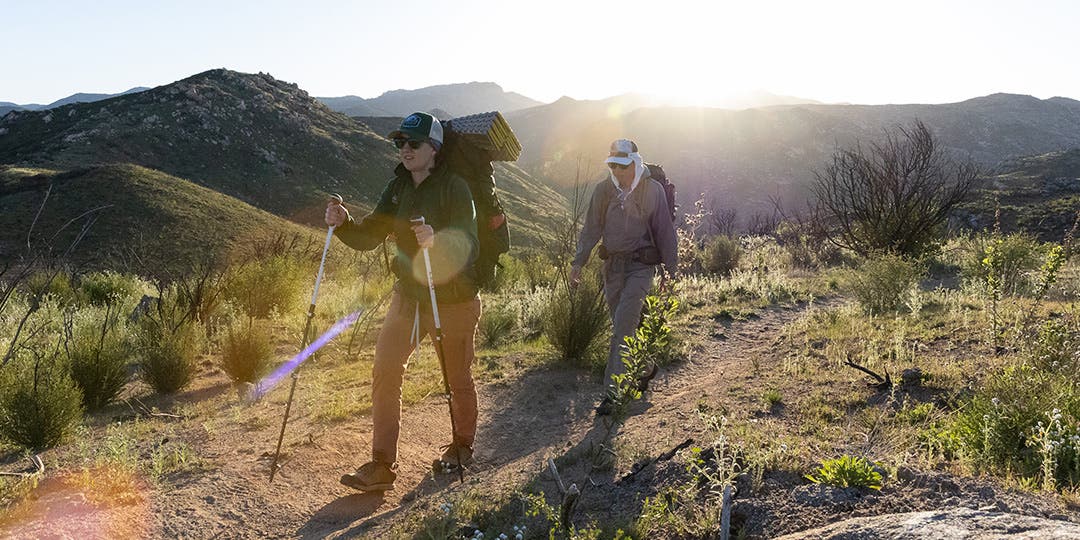Hiking is a great way to connect with nature and experience the outdoors, but as a beginner, it can be intimidating to know where to start. Whether you’re planning a short day hike or a multi-day trek, being well-prepared can make all the difference in your experience. We’ve outlined the best tips for hiking to ensure a safe and enjoyable time on the trails.


Plan Ahead
Before starting on any hike, it’s best to do some research about the trail: roundtrip length, difficulty, and its terrain. If you’re new to hiking, starting with a low-mileage (short) hike is a good option to gradually build your endurance and confidence on the trails. It’s also important to consider the elevation gain — shorter trails can still gain significant elevation, which makes for a much more difficult hike!
Choose The Right Gear
The best hiking gear will enhance your comfort and safety throughout the day. Investing in quality gear that fits well and is appropriate for the conditions will be important for a good hiking experience and help prevent discomfort or injury.
- Hiking Shoes: Wear comfortable hiking boots or sneakers with good traction — footwear that is durable, waterproof or semi-waterproof, and provides ample ankle support.
- Hiking Socks: Injijnji toesocks are the best socks for hiking, as they absorb sweat and prevent blisters. Injinji has a variety of styles to choose from, which cater to different preferences and hiking conditions. For a thin, lightweight sock that can serve as a baselayer or solo sock that wicks away moisture, choose the Liner Crew or Liner Mini-Crew sock. For an extra cushion and an added layer of protection, choose the Liner + Hiker Crew sock. For Midweight padding and odor-protection, choose an Outdoor Merino wool sock.
-
Hiking Clothing: It’s important to check the weather forecast so you know how to dress for the hike. Embrace the layers! Layering allows you to adjust your clothing to stay comfortable and regulate body temperature effectively throughout the day. Begin with a moisture-wicking baselayer to keep sweat away and add an insulating layer on top in colder temperatures to trap body heat. For additional protection against the elements, consider wearing a weather-resistant outer layer or jacket to shield against rain, snow, or wind. In warmer temperatures, a thin, lightweight buff helps to protect against UV rays and keep you cool.
What To Pack for a Hike
Before hitting the trails, it’s best to consider questions such as how to navigate, how to stay hydrated and how to fuel while hiking. For a safe and enjoyable outdoor adventure, consider packing the following items.
- Navigation: A map, compass, GPS device to help guide you through the trail. Trail markings are helpful, but they’re not always present or clear. If you’re relying on a mobile device for navigation, remember to download the trail map before reaching the trailhead – often, cellular service can be lost quickly!
- Hydration: Whether you bring ample water or opt for a filtered hydration system to draw water from streams, ensuring proper hydration will keep you energized and refreshed throughout the entirety of your hike.
- Nutrition: Lightweight, nutritious snacks – such as trail mix, energy bars, fruit, or PB&J – can help to keep you fueled during your hike.
- Identification: Carrying an ID or emergency contact information is important in case of unexpected circumstances.
- Trekking Poles: While not necessary, hiking poles offer added stability and help reduce strain on your joints, especially on steep, downhill, or uneven terrain.
Leave No Trace Principles
Remember, nature is our home! It’s important to minimize your impact on the environment by following the Leave No Trace principles. This includes packing out all trash, respecting wildlife, and being mindful of other hikers.
How To Stay Safe While Hiking Alone
Safety should always be a top priority, but it’s especially important when hiking solo. Remember these tips for hiking alone and exploring nature safely.
- Share your location: Prior to starting your hike, check-in with a trusted friend or family member, and update them on your intended route and expected duration.
- Stay on designated trails: Sticking to marked trails and avoiding shortcuts or veering off the path will help minimize the risk of getting lost or injured.
- Practice self-defense: Carrying bear spray or a personal alarm is recommended for added protection and an extra sense of security in unfamiliar environments.
- Stay alert: Keep your senses sharp! Opt for a headphone-less hike so you can stay vigilant of your surroundings.
Feeling ready to embark on an outdoor adventure? Don’t forget a trusted pair of Injinji toesocks to keep you blister-free and ready to tackle the challenges ahead.








